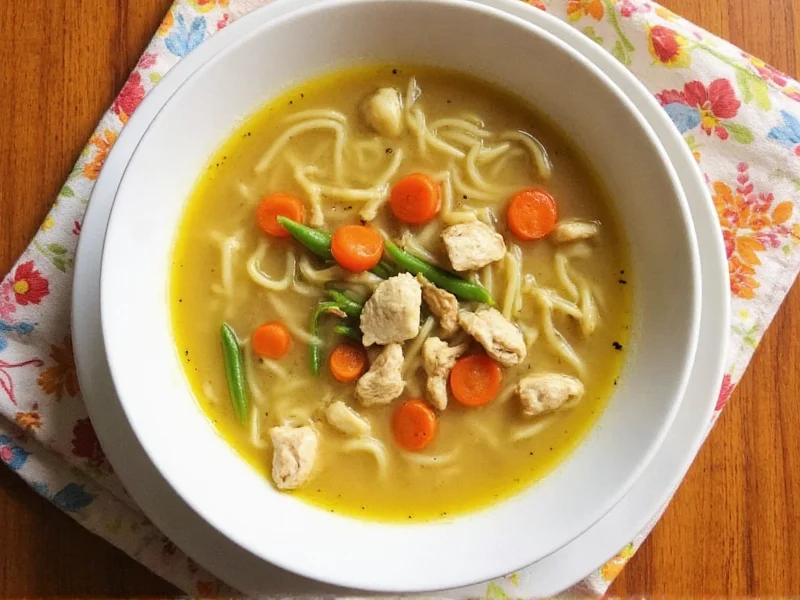Chicken noodle soup remains one of the world's most beloved comfort foods for good reason. This timeless recipe delivers more than just warmth—it offers a perfect balance of protein, vegetables, and carbohydrates in a single bowl. What separates an ordinary chicken soup from an extraordinary one lies in the technique, not complexity. The secret to exceptional flavor development starts long before the noodles hit the pot.
The Science Behind Superior Chicken Noodle Soup
Professional chefs and home cooks alike agree that broth quality makes or breaks this dish. Unlike store-bought versions, homemade broth extracts collagen from bones, creating that signature silky mouthfeel while providing gut-healthy gelatin. When chicken bones simmer slowly, they release amino acids that trigger umami receptors, explaining why properly made chicken soup feels so deeply satisfying.
Temperature control proves equally crucial. Boiling broth too vigorously emulsifies fat into the liquid, creating a cloudy appearance and greasy texture. Maintaining a gentle simmer allows impurities to rise cleanly to the surface for easy skimming, resulting in crystal-clear, refined broth.
Ingredient Selection: Quality Matters
Not all ingredients perform equally in this classic dish. Understanding why certain choices elevate your soup helps you make informed substitutions when needed.
| Ingredient | Recommended Choice | Avoid | Why It Matters |
|---|---|---|---|
| Chicken | Bone-in thighs or wings | Boneless breasts only | Bones provide collagen for rich texture; dark meat stays tender during long simmering |
| Noodles | Wide egg noodles or pappardelle | Thin pasta varieties | Wider noodles hold shape better and provide satisfying chew without becoming mushy |
| Vegetables | Fresh mirepoix (carrots, celery, onion) | Pre-cut frozen vegetables | Fresh vegetables release flavor gradually; frozen versions often become waterlogged |
| Herbs | Fresh parsley and thyme | Dried herbs only | Fresh herbs provide bright top notes that balance rich broth |
Step-by-Step Preparation Guide
Follow these detailed instructions for foolproof chicken noodle soup every time. This method maximizes flavor while preventing common mistakes like overcooked noodles or bland broth.
Building the Foundation (45 minutes)
- Place 1.5 lbs bone-in chicken thighs in a large stockpot with 8 cups cold water. Bring to just below boiling (190°F/88°C), then reduce heat to maintain a gentle simmer.
- Skim foam that rises to the surface during the first 15 minutes using a fine mesh spoon.
- Add 1 chopped onion, 2 celery stalks with leaves, and 3 garlic cloves. Simmer uncovered for 45 minutes.
- Remove chicken, strain broth through cheesecloth, and return clear broth to pot. Shred chicken, discarding skin and bones.
Developing Flavor Layers (25 minutes)
- Sauté 2 cups diced carrots and 2 cups diced celery in 2 tbsp olive oil until slightly softened (8 minutes).
- Add sautéed vegetables to strained broth along with 1 tsp black pepper, 1 bay leaf, and 4 sprigs fresh thyme.
- Simmer vegetables until tender but still firm (15 minutes).
Final Assembly (15 minutes)
- Add shredded chicken and 8 oz wide egg noodles to the pot.
- Cook until noodles reach al dente texture (8-10 minutes).
- Stir in 1/4 cup fresh chopped parsley and adjust salt to taste.
- Remove bay leaf and thyme sprigs before serving.
Avoiding Common Chicken Soup Mistakes
Even experienced cooks make these critical errors that compromise soup quality:
- Adding noodles too early—Egg noodles continue cooking in hot broth after removal from heat. Add them during the final 10 minutes to prevent mushiness.
- Over-salting at the beginning—Season in stages. Broth reduces during cooking, concentrating salt. Add 75% of salt at the end.
- Boiling instead of simmering—Rapid boiling makes broth cloudy and extracts bitter compounds from vegetables.
- Using only chicken breasts—Dark meat provides more flavor and stays tender during long cooking. Use a combination of dark and white meat.
Storage and Reheating Best Practices
Proper storage maintains quality for future meals:
- Cool soup completely within 2 hours of cooking to prevent bacterial growth
- Store broth and noodles separately if possible—noodles absorb liquid and become mushy when reheated
- Refrigerate for up to 4 days or freeze for 3 months in airtight containers
- When reheating, add a splash of water or broth to restore proper consistency
- Never boil reheated soup—gentle warming preserves texture and flavor
Variations for Dietary Needs and Preferences
Adapt this traditional chicken noodle soup recipe to suit various dietary requirements without sacrificing flavor:
Gluten-Free Chicken Soup
Substitute regular egg noodles with gluten-free alternatives made from rice or quinoa. Add them during the final 5-7 minutes of cooking since they cook faster. For enhanced flavor, toast the gluten-free noodles in olive oil before adding to broth.
Low-Sodium Version
Use unsalted homemade broth and enhance flavor with additional aromatic vegetables (leeks, fennel), lemon zest, and fresh herbs. Add 1 tbsp apple cider vinegar at the end to brighten flavors without salt.
Extra Nutrient Boost
Add 1 cup chopped kale or spinach during the last 5 minutes of cooking. Include 1/2 cup cooked white beans for additional protein and fiber. A sprinkle of nutritional yeast adds umami depth for vegetarian adaptations.
Why This Recipe Works for Cold Relief
Scientific research supports chicken soup's reputation as cold relief. The steam helps clear nasal passages while the warm liquid hydrates. More importantly, the amino acid cysteine released during cooking has anti-inflammatory properties similar to acetylcysteine, a medication used to treat bronchitis. The combination of vegetables provides vitamins A and C that support immune function, while the broth's electrolytes help maintain hydration during illness.











 浙公网安备
33010002000092号
浙公网安备
33010002000092号 浙B2-20120091-4
浙B2-20120091-4